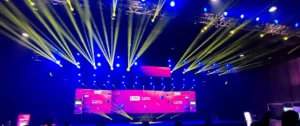Your event’s stage isn’t just a place for your speakers and performers to perform. It’s the focal point of your event, where your audience’s attention is focused. A great stage design elevates your entire event and leaves a lasting impression on your attendees.

So how do you make sure your stage design really stands out? Here are 8 key elements to consider:
1. Right Height
The height of your stage has a big impact on the audience’s viewing experience. Make sure it’s tall enough for all attendees, including the back rows, to see clearly. Depending on the venue’s layout, adjust the height as needed.

2. Lighting
Strategic lighting is essential for setting the mood and making sure the action on stage is visible. Whether you choose subtle spotlights or bright colors, strategic lighting will draw attention to your stage and emphasize key elements of your presentation.
Don’t forget the lighting. Presenters and performers need to be well-lit, both for the audience and for the videographers.

3. Audio for the Stage
Make sure your audio is crystal-clear. Invest in top-of-the-line sound equipment and expert audio technicians to make sure every word on stage is clear and loud.

Think acoustically, strategically place your speakers, and eliminate background noise.
4. Microphone Selection
Choose the right microphone. Whether it’s a handheld microphone, a lapel microphone, or a headset microphone, choose the one that best suits your speakers’ needs and the tone of your event.

Test your microphones before your presentation to avoid technical issues during the live show.
5. Lectern Use
Lecterns can be a great way to provide a comfortable place for speakers to take notes or make presentations. Make sure they fit in with the rest of the stage design and don’t block the view. Consider adding branding elements to make it look professional.

6. Overall Stage Design:
The overall stage design should be consistent with the theme and mission of your event and meet the needs of your presenters. Include elements such as a backdrop, branding and stage props for a visually attractive and unified look.
7. Accessible:
Make sure your event stage is accessible to everyone, regardless of their ability to walk or use a wheelchair. If necessary, install ramps or lifts and provide appropriate signage to point people in the right direction. This way, everyone will feel welcome and have a great experience.
8. Keep it simple
The best designs are often the simplest. Don’t feel the need to overwhelm your design with too many elements. A simple, well-designed design with the right components can be much more effective than one that’s cluttered and overwhelming.
If you follow these tips, you’ll be able to create a great event stage design that will not only work but also leave a lasting impact on your audience.
“Your stage is a blank canvas – use it to tell your event’s story and captivate your attendees!”




